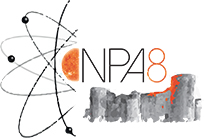Speakers
Dr
Aliya Nurmukhanbetova
(National Laboratory Astana, Nazarbayev University, Astana, 010000,Kazakhstan)Mr
Dosbol Nauruzbayev
(National Laboratory Astana, Nazarbayev University, Astana, 010000,Kazakhstan)
Description
% Nuclear Physics in Astrophysics 8 template for abstract
%
% Format: LaTeX2e.
%
% Rename this file to name.tex, where `name' is the family name
% of the first author, and edit it to produce your abstract.
%
\documentstyle[11pt]{article}
%
% PAGE LAYOUT:
%
\textheight=9.9in
\textwidth=6.3in
\voffset -0.85in
\hoffset -0.35in
\topmargin 0.305in
\oddsidemargin +0.35in
\evensidemargin -0.35in
%\renewcommand{\rmdefault}{ptm} % to use Times font
\long\def\TITLE#1{{\Large{\bf#1}}}\long\def\AUTHORS#1{ #1\\[3mm]}
\long\def\AFFILIATION#1#2{$^{#1}\,$ #2\\}
\begin{document}
{\small \it Nuclear Physics in Astrophysics 8, NPA8: 18-23 June 2017, Catania, Italy}
\vspace{12pt}
\thispagestyle{empty}
\begin{center}
%%%
%%% Title goes here.
%%%
\TITLE{Study of alpha cluster states in light nuclei for nuclear physics and astrophysics.}\\[3mm]
%%%
%%% Authors and affiliations are next. The presenter should be
%%% underlined as shown below.
%%%
\AUTHORS{A.K.Nurmukhanbetova$^1$, V.Z. Goldberg$^2$, D.K. Nauruzbayev$^{1,5}$, M.S.Golovkov$^3$, A.Volya$^4$,G.V.Rogachev$^2$ }
%%%
{\small \it
\AFFILIATION{1}{National Laboratory Astana, Nazarbayev University, Astana, 010000,Kazakhstan}
\AFFILIATION{2}{Cyclotron Institute, Texas A$\&$M University, College Station, Texas, USA}
\AFFILIATION{3}{Joint Institute of Nuclear Research, Dubna, Russian}
\AFFILIATION{4}{Department of Physics, Florida State University, Tallahassee, Florida 32306, USA}
\AFFILIATION{5}{Saint Petersburg State University, Saint Petersburg, Russia}
}
%%%
\vspace{12pt} % Do not modify
% Enter contact e-mail address here.
\centerline{Contact email: {\it anurmukhanbetova@nu.edu.kz}}
\vspace{18pt} % Do not modify
\end{center}
%%%
%%% Abstract proper starts here.
%%%
It is well recognized that current interest in $\alpha$ particle interaction with nuclei is strongly motivated by astrophysics [1]. Even if astrophysical reactions involving helium do not proceed through the strong $\alpha$-cluster states (because of their high excitation energy), these states can provide α width to the levels that are closer to the region of astrophysical interest through configuration mixing.
We used a low energy heavy ion cyclotron in Astana (Kazakhstan) to study resonance reactions induced by ions of \textsuperscript{13}C[2], \textsuperscript{15}N[3],\textsuperscript{16}O, \textsuperscript{17}O in helium and hydrogen gas target. The Thick Target Inverse Kinematics Method [3,4,5] was used to obtain the continuous in energy excitation functions in the large angular interval using 1.9 MeV/u initial energy of the accelerated ions. The experimental excitation functions were analyzed using multilevel multichannel R matrix code [6], and the data on over 100 levels were obtained. We did not use any background resonances in the fit. New data were obtained even for a well-studied case \textsuperscript{20}Ne nucleus populated in the \textsuperscript{16}O+ $\alpha$ resonance elastic scattering. The \textsuperscript{17}O+ $\alpha$ resonance elastic scattering has not been studied before. The nuclear structure theoretical calculations were made in the framework of the cluster-nucleon configuration interaction model [7].
In the talk we present the experimental results (Fig.1.), evaluate a shell model approach progress in the description of the cluster states, and consider modifications and a possible progress of the experimental approach.
\begin{figure}[h]
\centering
\includegraphics{fig-1-NPA8.jpeg}
\caption{The 180$^\circ$ excitation function for the \textsuperscript{16}O+ $\alpha$ resonance elastic scattering together with R matrix fit.}
\label{fig:awesome_image2}
\end{figure}
\bigskip
{\small
\noindent [1] A. Aprahamian et al. Nuclear structure aspects in nuclear astrophysics, Progress in Particle and Nuclear Physics. 54 (2005) 535–613. doi:10.1016/j.ppnp.2004.09.002;
\noindent [2] N.A.Mynbayev et al. J.Exper.Theo.Phys. 119, 663 (2014); Zh.Eksp.Teor.Fiz. 146, 754 (2014);
\noindent [3] A.K. Nurmukhanbetova et al. Implementation of TTIK method and time of flight for resonance reaction studies at heavy ion accelerator DC-60, Nuclear Instruments and Methods in Physics Research Section A: Accelerators, Spectrometers, Detectors and Associated Equipment. 847 (2017) 125–129. doi:10.1016/j.nima.2016.11.053;
\noindent [4] K. P. Artemov, et al., Sov. J. Nucl. Phys. 52, 634 (1990);
\noindent [5] G. V. Rogachev, et. al AIP Conf. Proc. 1213, 137 (2010);
\noindent [6] E.D.Johnson, Ph.D. thesis, Florida State University, 2013;
\noindent [7] A. Volya et al. Nuclear clustering using a modern shell model approach, Physical Review C. 91 (2015) 44319. doi:10.1103/PhysRevC.91.044319.
}
%%%
%%% End of abstract.
%%%
\end{document}
Author
Dr
Aliya Nurmukhanbetova
(National Laboratory Astana, Nazarbayev University, Astana, 010000,Kazakhstan)
Co-authors
Dr
Alexander Volya
(Department of Physics, Florida State University, Tallahassee, Florida 32306, USA)
Mr
Dosbol Nauruzbayev
(National Laboratory Astana, Nazarbayev University, Astana, 010000,Kazakhstan)
Dr
Grigory Rogachev
(Cyclotron Institute, Texas A&M University, College Station, Texas, USA)
Dr
Mikhail Golovkov
(Joint Institute of Nuclear Research, Dubna, Russian)
Dr
Vladilen Goldberg
(Cyclotron Institute, Texas A&M University, College Station, Texas, USA)

